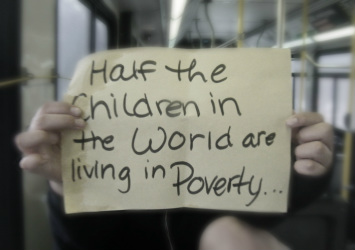Living off the city's mean streets

According to the UN High Commissioner for Human Rights, India has the largest population of street children in the world -- around 18 million, of whom nearly 2,50,000 live on the streets of Mumbai. Most of these children get by working as porters at bus or railway terminals, as mechanics in auto-repair shops, as vendors, as street tailors or as ragpickers.
The fate of a girl is very different from that of a boy on the street. "The average girl arriving in the city will last about 15 minutes before being approached by a person posing as a friendly stranger offering help," says Valerie Tripp of an NGO Saathi. "More often than not, these friendly strangers are agents who whisk away the unsuspecting girl to a brothel."
As for the boys, the railway platform is their permanent home. "They start with begging and selling knick-knacks, and when they get no money, they turn to crime," says Kasbe. "In many cases these children are picked by criminals to run errands."
Kasbe says these street children have a network of their own. "Most children who have been in the city for 15 days know where they can find free food," he says. The children form groups and head towards temples or shelters where food is distributed free, he says. They also know that they can find work in places like small hotels and shops.
An important aspect of street life is that most of these kids are in the dawn of puberty. For them, the mix of testosteronic rush and freedom is the gateway to all kinds of ‘experiments'. Very early in life, these kids develop a serious dependence on drugs. It is whiteners (“Typex”) and glues for the fattoos (who are beginners, usually aged between 8 to 10 years) while the dadas (or pros, aged 12 to 16 years) do ganja (marijuana) and charas. "A street kid, on an average, earns about Rs 70-80 a day (in 2009). Out of this, Rs 30 goes in procuring drugs. One may not get food to eat, but a day without drugs is impossible. Drug peddlers and addas operate openly in the bylanes of Paharganj and Jama Masjid right under the nose of the police," says Javed.
Besides drugs, sex is rampant. Young boys and girls become intimate after facing struggles together and fall in love. This fondness usually leads to sexual encounters among children. Homosexuality is common, and it is the younger kids of the lot who end up being exploited by their gang leaders, pimps, local goons and cops. "Usually, the kids indulge in unprotected intercourse, which leaves them vulnerable to all kinds of sexually transmitted diseases. Pregnancies in adolescent girls are routine. They either deliver the babies and run or lose their life in the process," says Shekhar.
Street children usually live in groups, and operate as one unit in their areas. At the New Delhi railway station, territories are specifically divided among numerous gangs, with each gang ‘owning' one platform. Every group consists of 10-14 members, and the eldest of the lot (and the strongest) is the undisputed leader. Boundaries are meant to be respected, and no trespassing is tolerated. Fights break out often, especially over food and money.
Still, in the midst of the hardships, friendship blooms. No street kid eats alone. Food is shared between all members of the group, even if it means sharing a single loaf of bread among eight of them. Anil recounts, "Once, one of my friends told us that there was a wedding near Ajmeri Gate. So we all quietly gate-crashed and gorged on chicken and biryani. When the guards came, we all grabbed whatever was around and managed to bring back some food for the others too."
Many of them escape grinding poverty at home, broken families or abusive parents, and bravely venture into the city to feed themselves, despite the extreme cold conditions or scorching heat in summer, which arrives just after winter in the month of May.
The fate of a girl is very different from that of a boy on the street. "The average girl arriving in the city will last about 15 minutes before being approached by a person posing as a friendly stranger offering help," says Valerie Tripp of an NGO Saathi. "More often than not, these friendly strangers are agents who whisk away the unsuspecting girl to a brothel."
As for the boys, the railway platform is their permanent home. "They start with begging and selling knick-knacks, and when they get no money, they turn to crime," says Kasbe. "In many cases these children are picked by criminals to run errands."
Kasbe says these street children have a network of their own. "Most children who have been in the city for 15 days know where they can find free food," he says. The children form groups and head towards temples or shelters where food is distributed free, he says. They also know that they can find work in places like small hotels and shops.
An important aspect of street life is that most of these kids are in the dawn of puberty. For them, the mix of testosteronic rush and freedom is the gateway to all kinds of ‘experiments'. Very early in life, these kids develop a serious dependence on drugs. It is whiteners (“Typex”) and glues for the fattoos (who are beginners, usually aged between 8 to 10 years) while the dadas (or pros, aged 12 to 16 years) do ganja (marijuana) and charas. "A street kid, on an average, earns about Rs 70-80 a day (in 2009). Out of this, Rs 30 goes in procuring drugs. One may not get food to eat, but a day without drugs is impossible. Drug peddlers and addas operate openly in the bylanes of Paharganj and Jama Masjid right under the nose of the police," says Javed.
Besides drugs, sex is rampant. Young boys and girls become intimate after facing struggles together and fall in love. This fondness usually leads to sexual encounters among children. Homosexuality is common, and it is the younger kids of the lot who end up being exploited by their gang leaders, pimps, local goons and cops. "Usually, the kids indulge in unprotected intercourse, which leaves them vulnerable to all kinds of sexually transmitted diseases. Pregnancies in adolescent girls are routine. They either deliver the babies and run or lose their life in the process," says Shekhar.
Street children usually live in groups, and operate as one unit in their areas. At the New Delhi railway station, territories are specifically divided among numerous gangs, with each gang ‘owning' one platform. Every group consists of 10-14 members, and the eldest of the lot (and the strongest) is the undisputed leader. Boundaries are meant to be respected, and no trespassing is tolerated. Fights break out often, especially over food and money.
Still, in the midst of the hardships, friendship blooms. No street kid eats alone. Food is shared between all members of the group, even if it means sharing a single loaf of bread among eight of them. Anil recounts, "Once, one of my friends told us that there was a wedding near Ajmeri Gate. So we all quietly gate-crashed and gorged on chicken and biryani. When the guards came, we all grabbed whatever was around and managed to bring back some food for the others too."
Many of them escape grinding poverty at home, broken families or abusive parents, and bravely venture into the city to feed themselves, despite the extreme cold conditions or scorching heat in summer, which arrives just after winter in the month of May.

